
The Rhine is one of the major European rivers. The river begins in the Swiss canton of Graubünden in the southeastern Swiss Alps. It forms part of the Swiss-Liechtenstein, Swiss-Austrian, and Swiss-German borders. After that the Rhine defines much of the Franco-German border, after which it flows in a mostly northerly direction through the German Rhineland. Finally in Germany the Rhine turns into a predominantly westerly direction and flows into the Netherlands where it eventually empties into the North Sea. It drains an area of 9,973 sq km and its name derives from the Celtic Rēnos. There are also two German states named after the river, North Rhine-Westphalia and Rhineland-Palatinate.

The Albula Pass is a Swiss mountain pass in the canton of Graubünden. It lies at the heart of the Albula Alps, on the watershed between the Albula, tributary of the Rhine and the Ova d'Alvra, tributary of the Inn. Overlooking the pass are the ranges of Piz Üertsch (north) and Crasta Mora (south).

The Vorderrhein is one of the two sources of the Rhine. Its catchment area of 1,512 square kilometres is located predominantly in the canton of Graubünden (Switzerland). The Vorderrhein is about 76 kilometres (47 mi) long, thus more than 5% longer than the Hinterrhein/Rein Posteriur. The Vorderrhein, however, has an average water flow of 53.8 m3/s (1,900 cu ft/s), which is less than the flow of the Hinterrhein. According to the Atlas of Switzerland of the Swiss Federal Office of Topography, the source of the Vorderrhein—and thus of the Rhine—is located north of the Rein da Tuma and Lake Toma.

Lai da Sontga Maria is a lake, located north of the Lukmanier Pass in Switzerland. It lies almost entirely in the municipality of Medel, a tiny fraction of the south-west part of the lake belonging to the municipalities of Quinto and Blenio. The reservoir has a surface area is 1.77 km2 (0.68 sq mi). The arch dam Santa Maria, which is to the north of the lake, was completed in 1968. The main road of the Lukmanier Pass runs along the eastern shore of the lake.

Lai da Curnera is a reservoir on the river Rein da Curnera in the municipality of Tujetsch, in the Grisons, Switzerland. The reservoir is linked to Lai da Sontga Maria and Lai da Nalps in the neighboring valley. The lake's volume is 41.1 million cubic metres (33,300 acre⋅ft) and its surface area 81 ha.
Lai da Rims is a lake in Val Müstair, Grisons, Switzerland. The surface area of 17 ha has an elevation of 2396 m. It is the largest lake in the Rom basin, which makes it also the largest lake in the Swiss portion of the Adige basin.

Piz Blas is a mountain in the Lepontine Alps, located on the border between the cantons of Graubünden and Ticino. At 3,019 metres above sea level, Piz Blas is the highest mountain of Val Cadlimo (Ticino), a valley drained by the Reno da Medel, a tributary of the Rhine. On its northern side (Graubünden), it overlooks the valleys of Lake Curnera and Lake Nalps, both drained by tributaries of the Rhine.
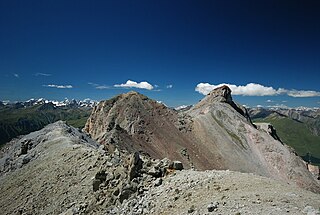
Piz Lischana is a mountain in the Sesvenna Range of the Alps, overlooking Scuol in the Swiss canton of Graubünden. With an elevation of 3,105 metres above sea level, Piz Lischana is the highest summit of the Sesvenna Range north of the Fuorcla Sesvenna.
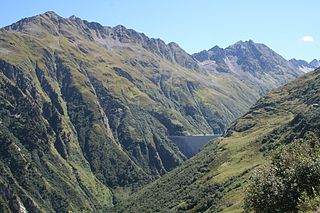
Piz Maler is a mountain of the Swiss Lepontine Alps, located south of Sedrun in the canton of Graubünden. It lies at the northern end of the range between Lai da Curnera and Lai da Nalps.
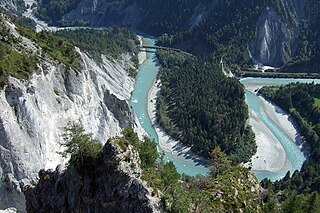
Lake Toma in the Swiss canton of Graubünden is generally regarded as the Source of the Rhine. Its outflow is called Rein da Tuma and after a few kilometers, it forms the Vorderrhein/Rein Anteriur. The course of this river is not particularly representative: after about two kilometers, its water is diverted into Curnera reservoir. The water is released at the Tavanase plant and flows into the Rhine at Ilanz. The river begins to be called Rhine in the vicinity of Chur, more specifically, at the confluence of the Vorderrhein and Hinterrhein/Rein Posteriur next to Reichenau in Tamins.

The Rein da Tuma is a river in Switzerland, in the Canton of Graubünden. It rises east of the Rossbodenstock with two or three mountain streams, that flow across the Tuma Alp into the Lake Toma. Before reaching the lake, it flows through a plain and forms small meanders. The Rein da Tuma flows out of Lake Toma on the north east and flows as Anterior Rhine past the village of Tschamut in the municipality of Tujetsch.

The Rein da Medel is the longest headwater of the Rhine. It is located in the Swiss cantons of Ticino and Graubünden and flows through the valleys Val Cadlimo and Val Medel. Rein da Medel is the local Sursilvan, name in Graubünden, which is commonly used to denote the Ticino part as well.

The Rein da Curnera is a right tributary of the Anterior Rhine and one of the main tributaries of the Rhine. It is fed from multiple sources and glaciers at the southern end of the valley. The river is about 8 kilometres (5 mi) long and flows north through the Val Curnera. Approximately in the middle of its route, a dam was constructed by Kraftwerke Vorderrhein AG, which formed Lai da Curnera. At this point, the Rein da Curnera takes up a left tributary, the Rein da Maighels.
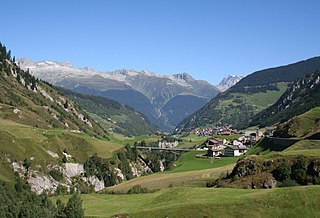
The Val Medel is a righthand side valley of the Surselva valley in Graubünden, Switzerland. It is approximately 15 km (9.3 mi) long and stretches from Disentis to the south, where it ends at Lai da Sontga Maria reservoir on Lukmanier Pass. There is a road through the valley and over Lukmanier Pass into Ticino.

The Valser Rhine is a source of the river Rhine in the Swiss canton of Graubünden. The river originates from the Länta Glacier and the Grauhorn Glacier at the northern foot of the Rheinwaldhorn and initially flows through the valley Länta before it flows into the Zervreilasee reservoir. Before the construction of the reservoir, the brooks Hornbach and Canalbach would flow into Valser Rhine from the right at the village of Zervreila. Today, the brooks flow into the reservoir, as does the Finsterbach, also from the right.
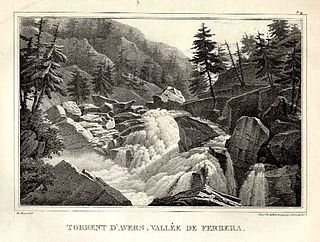
The Avers Rhine is a tributary of the Hinterrhein/Rein Posteriur in the Swiss canton of Graubünden.
Piz Denter is a mountain of the Lepontine Alps, located on the border between the Swiss cantons of Graubünden and Ticino. On its northern side (Graubünden), it overlooks the valleys of Lake Curnera and Lake Nalps, both drained by tributaries of the Rhine.

The Val Roseg is a valley of the Swiss Alps, located on the north side of the Bernina Range in the canton of Graubünden (Engadin). The valley is drained by the Ova da Roseg, a tributary of the Flaz, at Pontresina. Most of the valley is part of an exclave of the municipality of Samedan. Only the bottom of Val Roseg lies in the municipality of Pontresina.
The following is a list of Romansh exonyms, that is to say Romansh-language names for towns and cities that do not speak Romansh.

Piz Buin Pitschen (Rumantsch) or Kleiner Piz Buin (German) is a peak in the Silvretta Alps. The Piz Buin Pitschen lies western of his higher neighbor the Piz Buin Grond or Großer Piz Buin.

















